Tam Chuc Pagoda in Ha Nam - All You Need To Know About A Hidden Gem Of Spiritual Beauty
The Tam Chuc Pagoda in Ha Nam is one of the most popular places for tourists to visit in Vietnam. It is the biggest pagoda in the world. This temple is a part of the Tam Chuc - Ba Sao park, which has many important sites. People who like spiritual and cultural events will like going there. Together with Vietnam Budget Car Rental, let's see what makes this famous pagoda so beautiful.
>>Read more:
Some general information about Tam Chuc Pagoda in Ha Nam
Located in Ba Sao village, Kim Bang district, Ha Nam province, Vietnam, Tam Chuc Pagoda, which is also called Tam Chuc Zen Monastery, is a Buddhist temple. This famous tower stands out because of its fascinating design and beautiful setting between mountains and a lake. Three huge towers on the pagoda represent the Triple Gem, which is Buddha, Dharma, and Sangha. The towers were made in a style that combines elements of Chinese and Indian architecture.
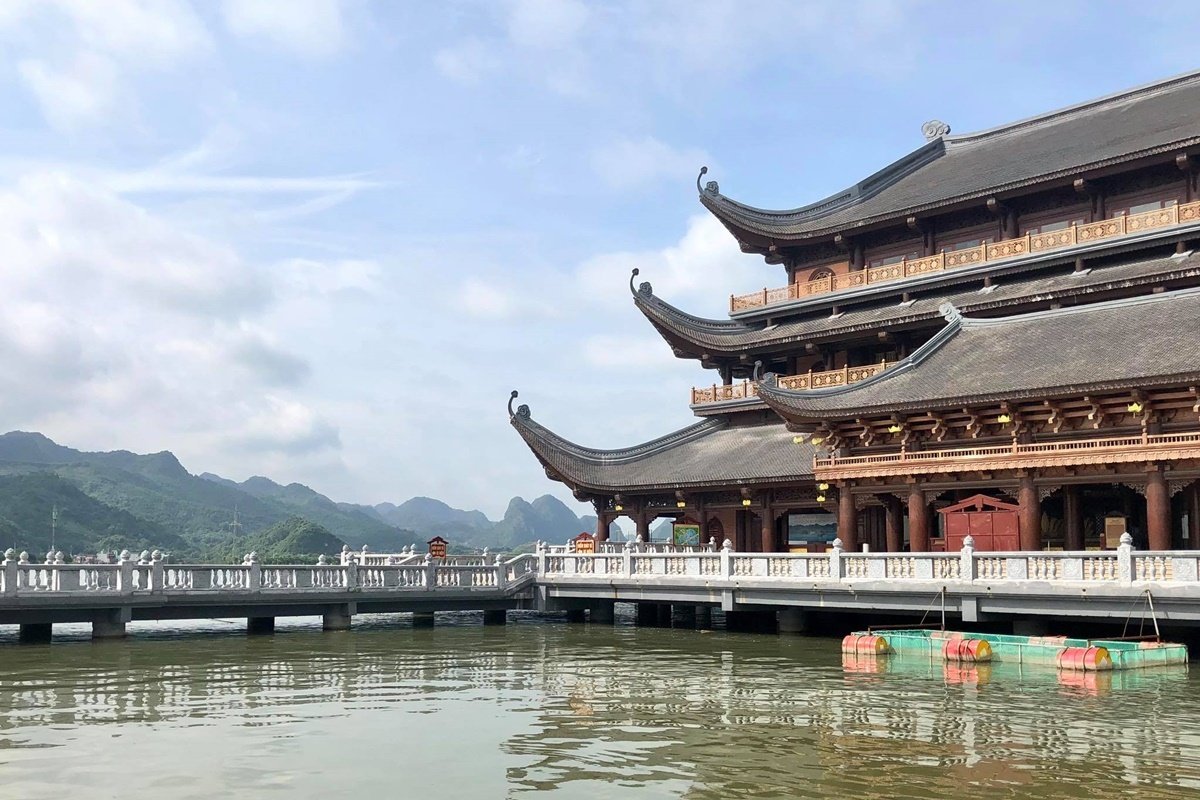
Some of the pagoda's other features include a long suspension bridge that spans Yen Tu Lake and its closeness to Cuc Phuong National Park, a popular place for wildlife. International and domestic tourists come to see it, and every year thousands of Buddhists come to see important rituals and events.
Furthermore, Tam Chuc Pagoda was picked to host the 2019 United Nations Day of Vesak, which is also known as Buddha's Birthday and is a big deal in the Buddhist community around the world. Attractive to tourists who want to learn about Vietnam's faith and culture, this place has stunning natural beauty and deep spiritual meaning.
When is the best time to visit Tam Chuc Pagoda in Ha Nam?
If your purpose for the trip is to explore and appreciate the serene beauty of Tam Chuc Pagoda, as well as immerse yourself in its sacred atmosphere, you can choose to visit at any time of the year. Regardless of the season, the pagoda will offer you a sense of tranquility and an opportunity to relish the peaceful space of this Buddhist gateway.
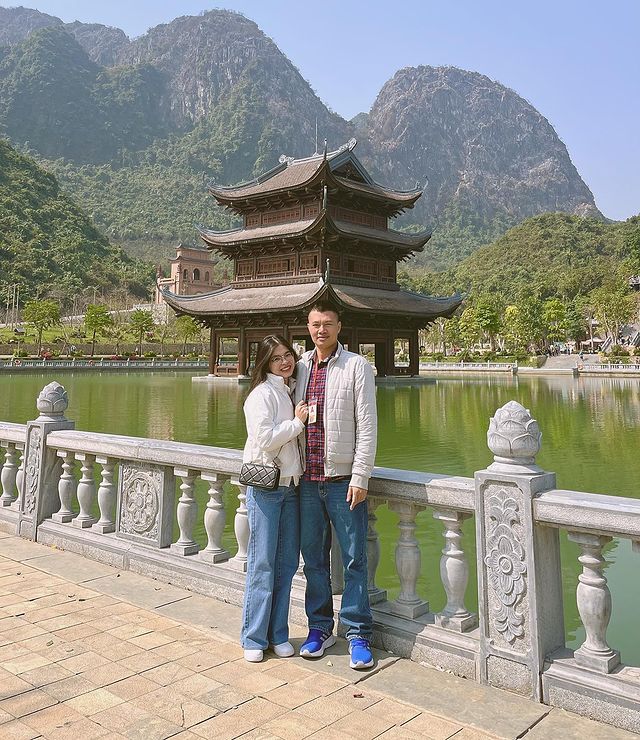
The ideal times for visiting Tam Chuc Pagoda typically fall between August to October and January to March each year. During August to October, it's the lotus season when Tam Chuc's natural scenery is at its most beautiful. The climate in Ha Nam province during this period is also relatively mild and pleasant.
Meanwhile, the period from January to March marks the festival season. There will be many lively and appealing activities happening during this time. Every spring, the pagoda holds opening ceremonies and announces the festivals planned for the year.
How do you get to Tam Chuc Pagoda in Ha Nam?
Tam Chuc Pagoda in Ha Nam is only about 70km from the center of Hanoi, so you have various transportation options like taking a bus, a motorbike, and more. However, it's advisable to rent a private car in Hanoi and head to Tam Chuc Pagoda because it's the most comfortable and safe option, allowing you to have a more fulfilling experience during your journey.
If you're driving, take the Giải Phóng Road, pass through Nước Ngầm ferry, then head towards Thường Tín – Phú Xuyên direction. When you reach the intersection of QL1A highway, merge onto the national highway and continue towards Phủ Lý direction. After that, follow the QL21 road for about 10km, and you'll arrive at the pagoda.
The history of Tam Chuc Pagoda in Ha Nam
Tam Chuc Ancient Pagoda was constructed during the Dinh Dynasty about 1,000 years ago and holds a unique position surrounded by Tam Chuc Lake, with the Thất Tinh mountain range behind it, closely associated with the legend of "Former Six Fairies - Later Thất Tinh." According to the tale, in ancient times, the Tam Chuc mountainous area had seven bright stars atop seven peaks, embodying the appearance of seven celestial maidens who descended to Earth.
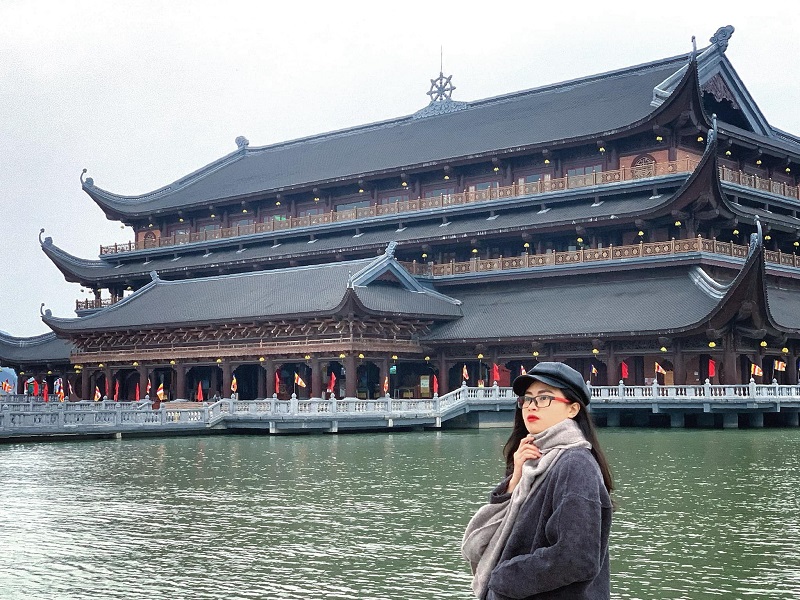
Enchanted by the beauty of this place, these maidens were so absorbed in playing that they didn't return home, causing the heavenly kingdom to send someone wielding celestial weapons, such as bells, to call them back six times, but each attempt was unsuccessful. One can now see six small islands emerging in the lake, which are said to be the six bells left behind by the celestial beings, and the seven peaks represent the Thất Tinh mountains.
In the history of Tam Chuc Pagoda, it's mentioned that some locals once ascended the Thất Tinh mountains, attempting to take away these seven stars. However, a massive fire they lit up to achieve this goal ended up dimming four of the stars, leaving only three. It was from that event that the Thất Tinh Pagoda within the Tam Chuc area earned the name "Ba Sao Pagoda," and the Ba Sao town was also named after this legend.
Top things to explore at Tam Chuc Pagoda in Ha Nam
1. Ngoc Pagoda
The Ngoc Pagoda, which is also called the Heaven Altar, is one of the buildings in the Tam Chuc Pagoda complex. It is 200 metres above sea level on top of Thất Tinh Mountain. From Ngoc Pagoda, you can see the Tam Chuc mountains in all their beauty, like something out of a watercolour drawing.
The 15-meter-tall pagoda is made of 2,000 tonnes of red basalt stones that fit together without any glue or cement. All of the stones were made in India and then brought to Vietnam to be put together in the traditional way of Vietnamese architecture.

As people climb the 299 steps that lead to the pagoda, they will see a statue of Amitabha Buddha made of a valuable gem from Myanmar that weighs 4.9 tonnes and is made of ruby. A figure of Guan Yin Bodhisattva made from a solid block of white jade that weighs about 5 kg stands next to it. These are valuable items from Quan The Am Pagoda in Danang, which is home to Vietnam's first Buddhist museum.
2. Tam The Palace
The next stop along the spiritual axis of Tam Chuc Pagoda is Tam The Palace, located 45m above sea level. The three-tiered curved-roof palace is constructed in the distinctive architectural style of Vietnamese temples and is the largest hall, accommodating 5,000 Buddhists for ceremonies simultaneously.
Passing through intricately carved wooden doors are three bronze statues of Tam The, cast in black bronze, placed in front of a relief sculpture in the shape of a lotus leaf, symbolizing the past, present, and future. Each statue weighs up to 200 tons.
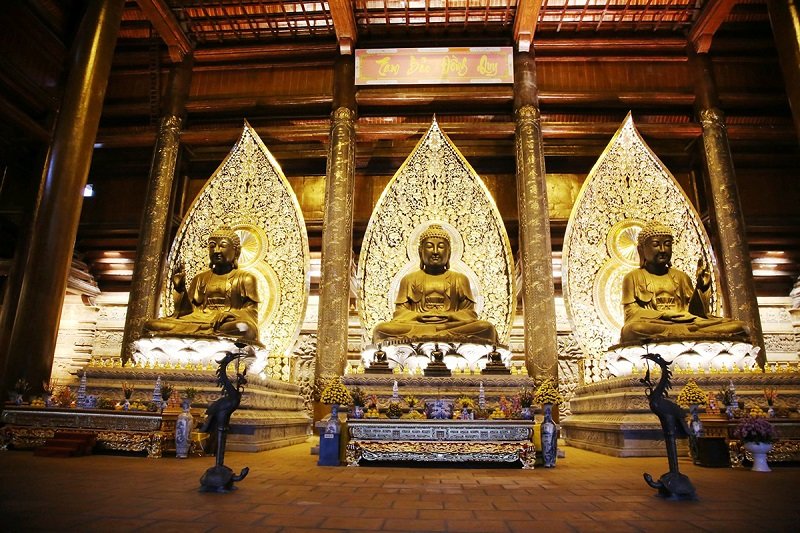
Each wall within Tam The Palace presents a theme. When traversing from left to right in a clockwise direction, the philosophical stories of Buddhism gradually unfold, from the Dharma Wheel to the Nirvana realm.
Moreover, in front of the entrance to Tam The Palace, a Bodhi tree propagated from a 2,125-year-old Sri Lankan Bodhi tree, a national treasure, was gifted by the President of the Sri Lankan Parliament.
3. Dharma Master Palace ( Điện Pháp Chủ )
Beneath Tam The Palace lies the Dharma Master Palace, distinguished by a 150-ton solid bronze statue of Shakyamuni Buddha. The highlight of Dharma Master Palace is four large relief sculptures enveloping the walls, depicting pivotal stages in the life of Shakyamuni Buddha, from his birth, enlightenment, preaching, to his entering Nirvana.
4. Quan The Am Palace
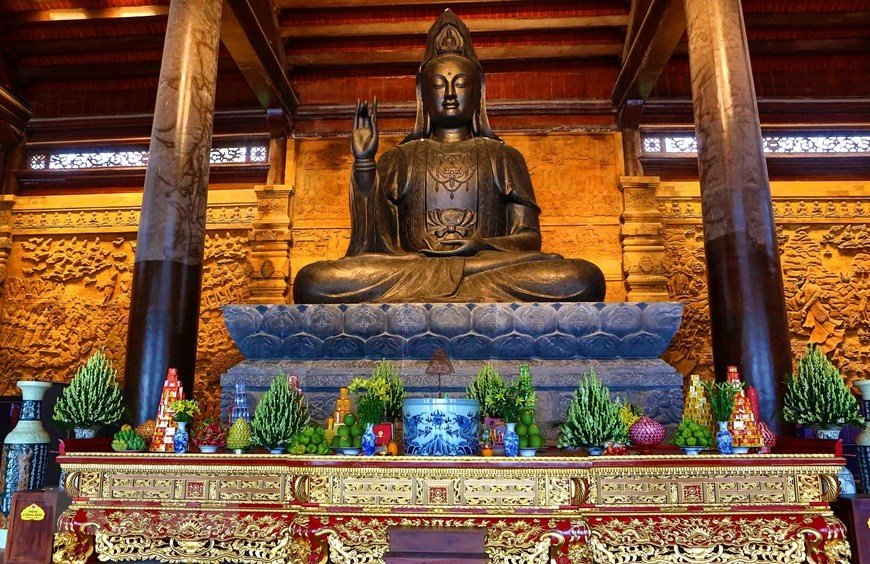
The Quan The Am Palace is dedicated to the Bodhisattva Quan The Am and has relief carvings that show how kind and selfless Shakyamuni Buddha was. This shows his many reincarnations over many lifetimes to save people.
The engraved drawings of old stories from the Avatamsaka Sutra, an important Buddhist text, are another great thing about Quan The Am Palace.
In particular, the relief sculptures in all three buildings are made from stones taken from Indonesia's Merapi volcano and carved by skilled workers from Java Island. Along with the statues, the relief carvings have written messages in three languages: encrypted Vietnamese, English, and Sanskrit.
5. Three-Gate Entrance
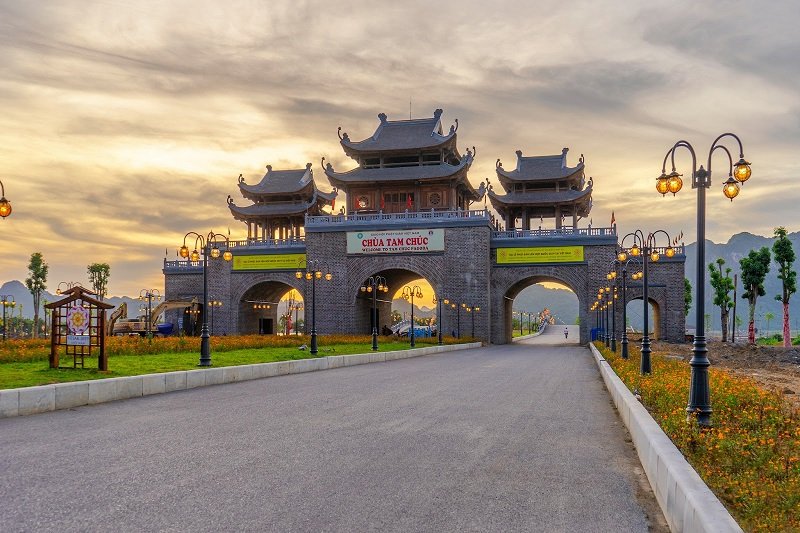
In contrast to most churches, Tam Chuc Pagoda has two Three-Gate Entrances: one on the outside called the Outer Three-Gate Entrance and one on the inside called the Inner Three-Gate Entrance. The Three-Gate Entrances are large, three-story buildings that are the most famous part of the Tam Chuc Pagoda complex.
The Outer Three-Gate Entrance is where you can buy tickets for boats or electric vehicles. The boat dock is past the gate, and the electric vehicle stop is close to the parking lot. There are also paths for people to use to get to the Inner Three-Gate Entrance.
The old bonsai tree really makes the Inner Three-Gate Entrance area stand out. It gives it a special charm. Here, people start to get a sense of how huge and beautiful the Tam Chuc Pagoda complex really is.
6. Pillar Garden
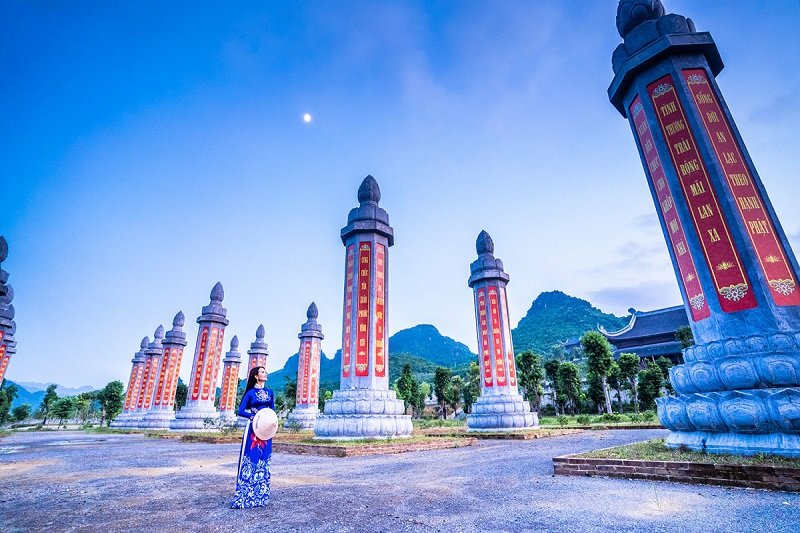
Passing through the Inner Three-Gate Entrance, you'll reach the area of 32 pillars, also known as the Pillar Garden, a unique highlight contributing to the majestic ambiance of Tam Chuc Pagoda.
The pillars, unique creatures, symbolize the wish for prosperity, national peace, and prosperity. The pillars at Tam Chuc Pagoda weigh up to 200 tons, made from Thanh Hoa green stones, standing approximately 14 meters high.
The pillar base is designed in the shape of a lotus pedestal, the pillar body in hexagonal form, and the top is a lotus bud, surrounded by intricately hand-carved Buddhist teachings.
7. International Conference Center
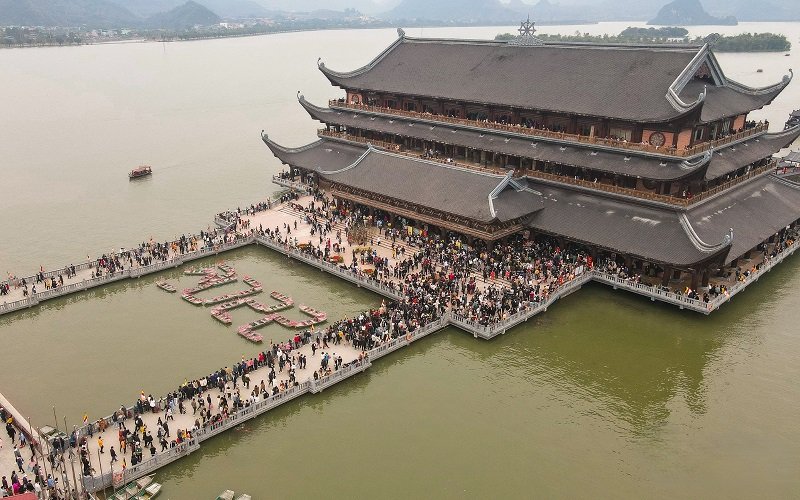
The International Conference Centre, which is also called Thuy Dinh Guest House, is the first thing you see when you get to Tam Chuc Pagoda in Ha Nam and marks the end of the spiritual line. Built on the water to look like a lotus flower in bloom, it's a great place to take beautiful pictures of the scenery.
When Buddhist groups come to Thuy Dinh for ceremonies, solemn plans are made for them to arrive. Around it are LED-lit drawings that show the scenery of Tam Chuc Pagoda as a whole.
8. Tam Chuc Shrine
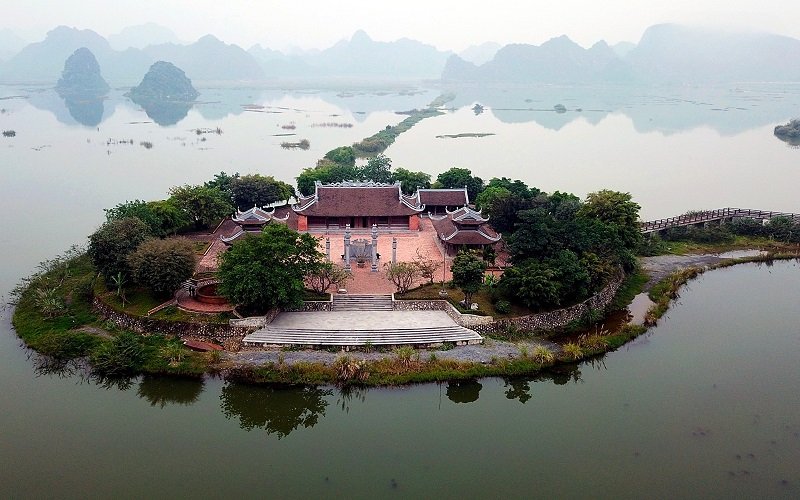
The Tam Chuc Shrine, not excessively grand in scale but carrying significant meanings, is an embodiment of ancient Northern-style communal house architecture. Nestled amidst the water, it is dedicated to worshiping Queen Dinh Duong Thi Nguyet, King Dinh Tien Hoang, and the White Horse deity.
To reach the shrine from the pagoda, visitors must cross a zigzag bridge across Tam Chuc Lake. The serene and expansive space here is a favorite check-in point for many young visitors.
Other attractions near Tam Chuc Pagoda in Ha Nam
1. Bai Dinh Pagoda
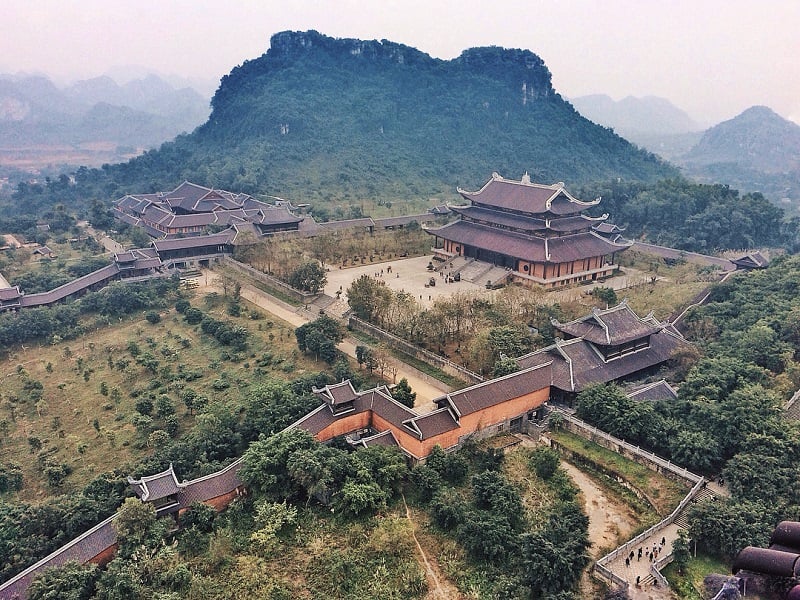
This famous Bai Dinh Pagoda holds numerous national and regional records. It boasts a gigantic gold-plated Buddha statue, renowned throughout the region. Furthermore, this pagoda exudes an aura of ancient reverence and is one of the prominent golden triangle destinations in Vietnam.
2. Ngu Dong Thi Son
Ngu Dong Thi Son refers to five caves with mysterious stalactites, taking peculiar shapes resembling turtles, elephants, milk jugs, and more. As these five caves interconnect, visitors can explore all of them within a single itinerary.
3. Ba Sao Pagoda
Covering 44 hectares, Ba Sao Pagoda is situated within the vast Tam Chuc tourist area. It's one of the key points in the golden triangle, alongside Huong Pagoda and Bai Dinh Pagoda. Every year, numerous tourists flock here for visits.
4. Tran Thuong Temple
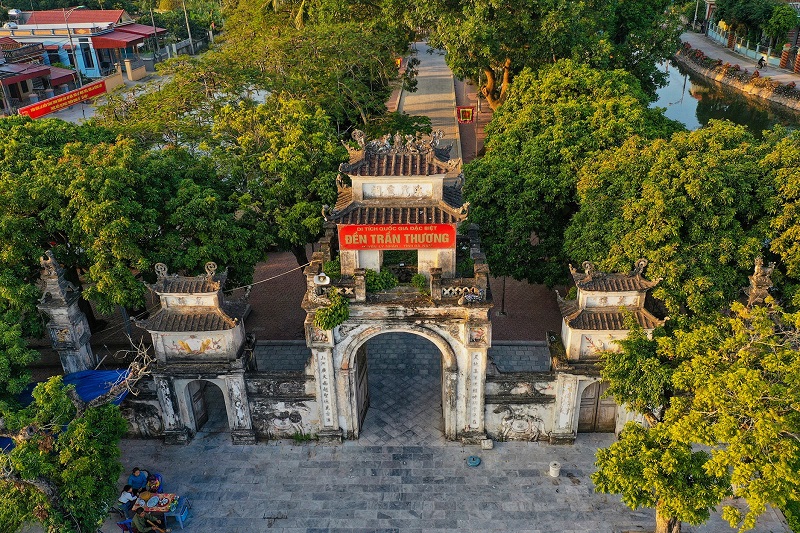
This temple venerates Tran Hung Dao and has been standing for a long time. Legend has it that the temple was built on land that used to be a granary for the Tran dynasty's army in 1285. Within the temple lies the famous Ngoc Well, believed to house the remains of the talented military leader.
5. Van Long Lagoon
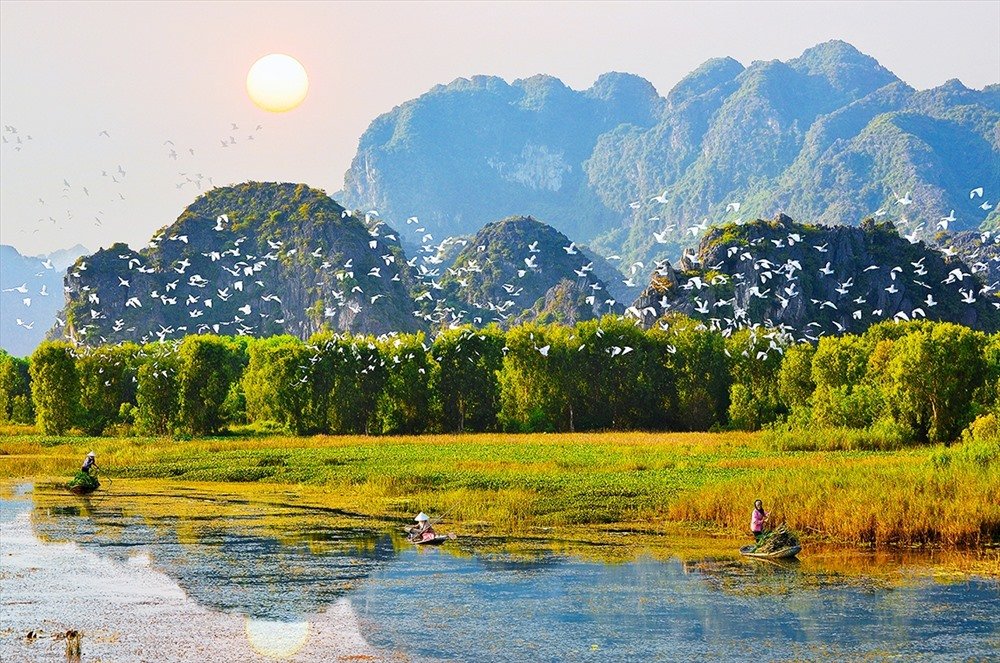
Van Long Lagoon is the largest natural lagoon in the northern region of Vietnam, located in Ninh Binh. This area is recognized as a national tourist spot, home to diverse wildlife, particularly the critically endangered Delacour's langur. Since 1998, this area has consistently attracted a multitude of tourists.
These are travel experiences at Tam Chuc Pagoda in Ha Nam for your first visit. Vietnam Budget Car Rental hopes to provide you with the necessary information concisely to help plan your trip. If you have any additional information to share, feel free to let us know!
